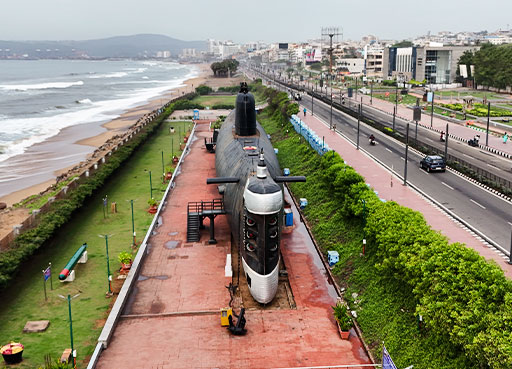
KURUSURA SUBMARINE MUSEUM- THE UNDERWATER EXPERIENCE ON SURFACE:
The INS Kursura Submarine Museum is a landmark in Visakhapatnam's tourism chapters, and it is the first of its kind in South Asia. The INS Kursura, a Soviet-built I-641 class submarine, was inducted into the Indian Navy on December 18, 1969, and was decommissioned on February 27, 2001, after 31 years of glorious service to the nation. The entire submarine, including the weapon package, was hauled from the sea to land and positioned on a concrete foundation at Gajapathi Raju Marg, Ramakrishna Beach Road, Visakhapatnam. The setup of the submarine museum cost approximately Rs. 6.00 crores, with technical support from the Naval Ship Design and Research Center. The submarine is 91.3 meters long and 8.00 meters wide.
The Kursura Submarine Museum was dedicated to the nation on August 9, 2002, by Sri N. Chandrababu Naidu, the Hon'ble Chief Minister of Andhra Pradesh, and opened to the public on August 14, 2002, by VMRDA.
The museum receives an overwhelming response from visitors. Pilgrims, tourists, and students from various parts of the country and the globe visit Visakhapatnam and make their moments memorable at this unique underwater unit on land. State VIPs and guests from various public and private organizations also prefer to see this amazing spot on the seashore.
Announcing The Ever Prestigious :
INS Kursura, the underwater behemoth of the Indian Navy, is located on the golden sands of RK Beach, from which the now prestigious Submarine Museum emanated. This project was undertaken by the Eastern Naval Command in collaboration with the National Ship Design and Research Center. Recognized by the Navy as a War Memorial, the museum had a project cost of Rs. 5.5 crores. It is the first of its kind in Asia and ranks second in the world. The submarine, made of steel and modeled after Russian designs, is 91 meters long and was not hindered by enemy assaults during its operational period. INS Kursura was commissioned on December 18, 1969, tasked with patrolling Indian waters and blocking threats from enemy forces.
Life on a Submarine:
The submarine underwent rigorous training at INS Sathavahana, including damage control, drills, emergencies, battle tactics, and escape training through a vertical (100') tower. A sea experience of 6 months qualifies the submarine for the prestigious Dolphin Badge, highly coveted in the field. Space on a submarine is premium, with a focus on equipment, ammunition, and life-saving systems. Officers and sailors share limited bed space through hot bunking. Daily activities on a submarine include action stations, maintenance, and weapons firing. In a kitchen measuring 4' x 6", two cooks prepare meals for the entire crew. The 77 men on board share two wash basins and two toilets for a month at sea.
Welcome Onboard :
Name : INS KURUSURA
Class : I-641
Make : USSR
Commissioned : December 18, 1969
Length : 91.3 meters
Breadth : 8.00 meters
Displacement : 1945 Tons (Surfaced), 2469 Tons (Submerged)
Compliment : 08 Officers, 69 Sailors
Diving depth : 280 meters
Speed : 15.5 Knots
Propulsion : 3 Diesel Engines, 448 Batteries
Torpedoes : 22
Training in the vast oceans, the submarine played a crucial role in commanding blue waters and penetrating enemy territory. It is equipped with 22 torpedoes and can reach speeds of nearly 15.5 knots. On February 27, 2001, after 31 years of service, INS Kursura was decommissioned. Now, it reveals its glorious saga of underwater exploits.
Come and discover the untold mystery of the INS KURSURA.
The Eastern Naval Command launched a prestigious project to set up a unique Submarine Museum, the first of its kind in Asia, on the beachfront near the war memorial. The aim was to enhance the tourist potential of the city.
Amid the breathtaking beauty of the blue waters and golden sands of Vizag Beach lies the INS Kursura Submarine Museum. It instills a sense of sacrifice and patriotism in visitors. The museum not only showcases the history of submarines but also highlights the hardships faced by those who served on them.
INS Kursura, the Navy’s fourth submarine, was hauled onto the beach in February 2001. It is an engineering marvel, involving complex processes of high order. The final phase of civil works enhanced the museum for regular public viewing, with special modifications to facilitate visitors in exploring the interior of the decommissioned submarine.
The submarine, in all its grandeur, showcases its complete weapon package from sea to land and is positioned on a concrete foundation. Its interior design blends seamlessly with the scenic beauty around it. The museum displays milestones in submarine evolution through artifacts, photographs, and written scripts, aiming to broadcast the glory of the submarine arm and provide glimpses into the lives of those involved. It also reveals the challenges and efforts of its crew. Visakhapatnam, known for its stunning landscapes, has become a popular destination, and it is no exaggeration to say that no other place in Andhra Pradesh offers such scenic surroundings. This credit goes to the Visakhapatnam Metropolitan Region Development Authority (VMRDA), which, in collaboration with Andhra Pradesh Tourism, has undertaken many innovative measures to develop the city into a landmark of beauty. The city offers picturesque views and recreational spots like NTR VMRDA Park, the Buddhist complex at Thotlakonda, and many other vibrant displays by VMRDA, adding to the city's allure. The INS Kursura Submarine Museum serves as a platform to raise awareness about submarine operations and its crew.